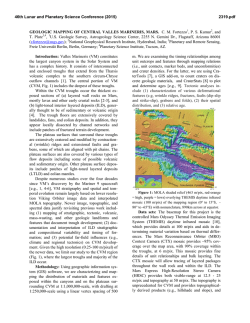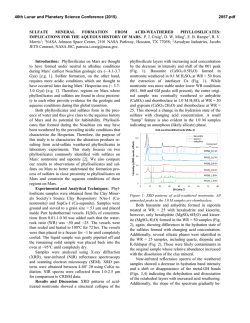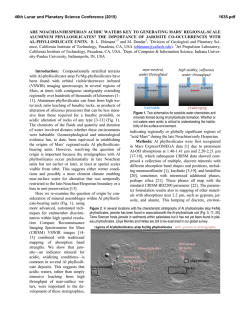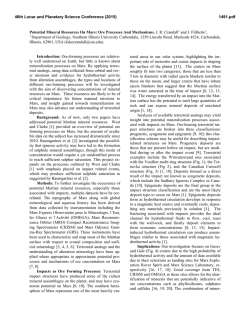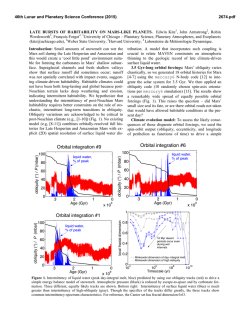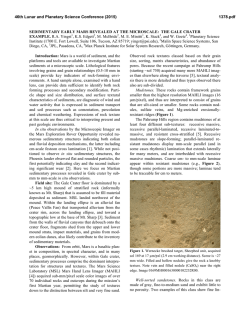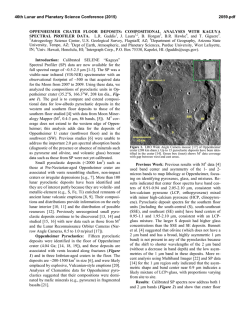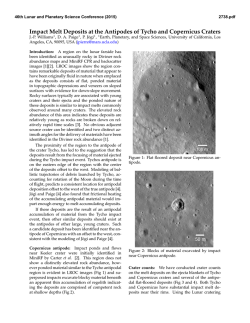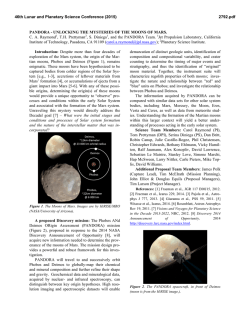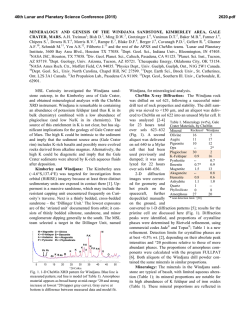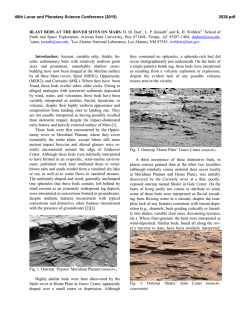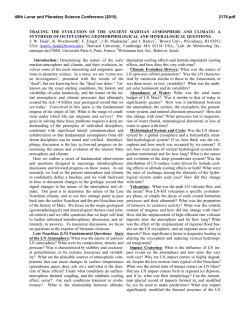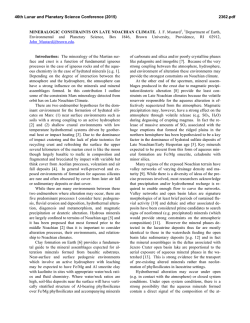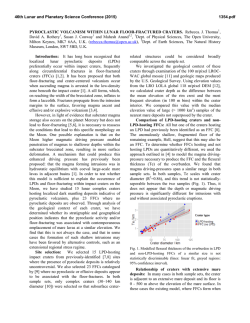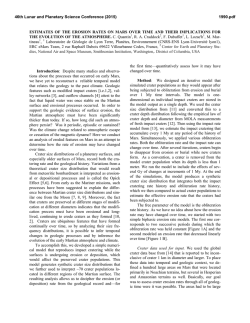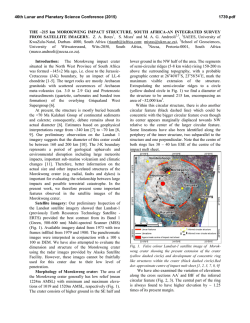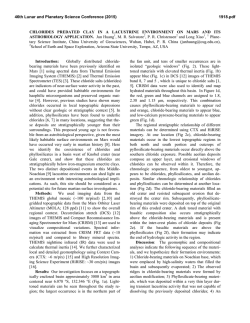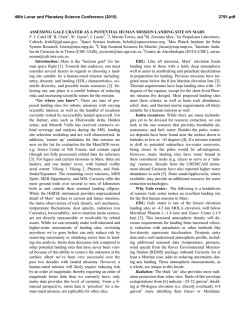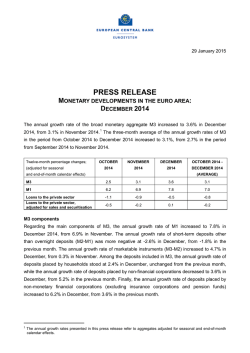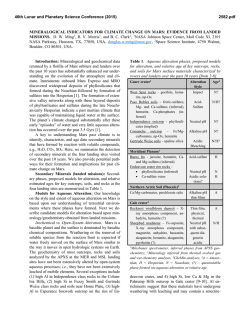
CONSTRAINTS ON THE PAST CLIMATE OF MARS FROM
46th Lunar and Planetary Science Conference (2015) 2509.pdf CONSTRAINTS ON THE PAST CLIMATE OF MARS FROM MERGING OF IN SITU AND ORBITAL ANALYSES OF MARTIAN HYDRATED MINERALS. F. Poulet1, J. Carter1, R.E. Arvidson2, J.-P. Bibring1. 1 Institut d’Astrophysique Spatiale, CNRS/Univ. Paris Sud, 91405 Orsay Cedex ([email protected]), 2 Dept. of Earth & Planetary Sciences, Washington University, St. Louis, MO. Introduction: During the last decade, the Mars Exploration Rovers and the Mars Science Laboratory have in all traversed more than several tens of kilometers across the Martian surface, while four spacecraft have orbited the planet. This plethora of orbital and rover-based observations allows for comprehensive, coordinated analyses of data regarding to hydrated mineral deposits, which are key for understanding the past climate conditions. Here, we conduct a coordinated analysis of aqueous-related mineral phases (phyllosilicates, sulfates, carbonates, hydrated silica) revealed by both orbital and in situ instruments, in order to better constrain the past aqueous environments in which these minerals were formed. Implications on the past climatic conditions are discussed. Gusev Crater: Formation and deposition by an aqueous ponding event. Using CRISM data, Fe/Mg phyllosilicates were identified in deposits located >50 km from the landing site [1]. Although these clays could be either detrital or formed from primary phases authigenically alteration, their occurrence associated to fluvial-lacustrine sediments supports the presence of a past lake. Conversely, the various additional altered phases that were detected by in situ instruments [2-5], were interpreted to result from (volcanically driven) hydrothermal activity. CRISM images reveal spectral signatures of Fe- and Al-rich phyllosilicates in the Columbia Hills, and the presence of carbonates at the Comanche outcrops and additional locations [1,6]. The absence of phyllosilicates combined to the presence of substantial (~50%) amorphous and npOx components by Spirit point to a poorly crystalline phyllosilicate. This complex mineralogy revealed by both in situ and orbital data shares some similarities with the compositions and chemical gradients of some altered deposits identified elsewhere on Mars, especially in the Terra Sirenum region [e.g., 7]. The plateau plains of this region contain scattered exposures of Al‐phyllosilicates and one isolated mound with opaline silica, in addition to more common Fe/Mg‐phyllosilicates with chlorides. A possible geochemical analog for the deposits of northwest Sirenum is provided by Western Australian acid saline lakes [6]. Recent geochemical modeling of carbonate-bearing outcrops of the Columbia Hills also indicates low leaching and evaporative precipitation [8]. Consequently, the full set of observations over Gusev crater strongly converges towards a pondingrelated formation for many weathered phases detected in the Columbia Hills, with a period of liquid water coming from the aqueous deposition of sediments on the crater floor. Meridiani Planum: Neutral and acidic (ground and surface) water. Both hematite and sulfates were observed from orbit [9-10] and analyzed in situ by Opportunity [11]. The first investigations supported highly acidic conditions having occurrred in this region, with both in situ and orbital observations indicating that aqueous processes studied by Opportunity in Meridiani Planum were widespread. However, there is also evidence that the aqueous solutions from which most of the etched sedimentary terrains were formed have a higher pH. Several occurrences of phyllosilicate-rich materials have been identified in the etched terrains [12, 13], and both ferric hydroxides (ferrihydrite, lepidocrocite) and ferric sulfates (amarantite, schwertmannite) are good candidates to explain the nearinfrared spectral properties of etched terrains [12]. Diverse landforms including karsts and pan features are observed at the surface of the hydrated etched terrains and indicate past surface runoffs and potential groundwater aquifers [13]. Phyllosilicates are also exposed in the rim of Endeavour crater, representing older, underlying rocks formed in less acidic conditions. [14-15]. Therefore, both local and large scale observations suggest a complex aqueous history with an early period of localized intense alteration under fluid-dominated, near-neutral to modestly low pH (locally very low) and reducing conditions. Gale crater : an example for (early) Hesperian fluvio-lacustrine deposits. The regional geologic context, sedimentologic framework, and geochemistry and mineralogy of the Sheepbed mudstone point to a neutral pH fluvial-lacustrine environment during the postNoachian history of Mars [16]. Quantitative mineralogy derived from in situ CheMin measurements reveals detrital basaltic materials mixed with secondary phases [17,18]. Orbital observations are unable to detect the clay-bearing Sheepbed mudstone member of the sedimentary Yellowknife Bay formation due to a mask by dust. The presence of clays has been nevertheless reported in many other fluvial-lacustrine deposits on Mars [19]. We modeled the composition of the two deltas present in the Eberswalde and Holden craters [20]. Their modal mineralogies inferred from orbital data can be then compared to CheMin values (Table 1). 46th Lunar and Planetary Science Conference (2015) There is an excellent agreement between the modal mineralogies of Yellowknife and Eberswalde hydrated deposits. The composition of smectites as well as the isochemical alteration favor an authigenic formation of clay minerals at Gale [16]; a detrital origin was proposed for Eberswalde in association with authigenic processes to explain the presence of opal [20]. However, the formation processes inferred for Eberswalde delta and the Peace alluvial fans both involve only limited surface water flow, ponding, and chemical alteration at the surface. We suggest that the conditions prevailing in the formation of Yellowknife could be representative of many lacustrine deposits observed on Mars. Implications for past climatic conditions. The formation of the hydrated deposits present in these three sites is best explained by the past presence of liquid water at the surface. Their formation is roughly from late Noachian to Early Hesperian in age (Figure 1). The full set of observations summarized here confirm that aqueous alteration with standing body of liq- 2509.pdf uid water was once widespread on the surface during the Noachian and near the Noachian-Hesperian boundary. Although the conditions at Gale crater could indicate rather arid environment, such conditions could have occurred (at least episodically) possibly as late as the Early Amazonian for Eberswalde and other lacustrine deposits observed on Mars. Table 1. Comparison of the mineral abundances inferred from Curiosity [17] and CRISM orbital measurements [19]. Mineral Yellowknife Eberswal- Holden Phase bay (JK & de deltaic deltaic CL) deposits deposits Clay minerals 18-22 10-25 25-45 Plagioclase, 50-53 50 40-45 amorphous phases Pyroxenes 12-16 30 10-20 Figure 1. Timing of the formation of the hydrated deposits compared to the sequence of major planetary conditions (adapted from [22]). References : [1] Carter J. & Poulet F. (2012) Icarus, 219, 250–253. [2] Morris R.V. et al. (2010), Science, 329, 5990, 421-424. [3] Haskin L.A. et al. (2005), Nature, 436, 66-69. [4] Squyres S.W. et al. (2006), JGR., 111, E02S11. [5] Squyres S.W. et al. (2008), Science, 320, 1063-1067. [6] Poulet F. et al. (2013), LPS 45, Abstract # 1739. [7] Wray J. et al. (2011), JGR, 111, E01001, 1–41. [8] Ruff S.W. et al. (2014), Geology, 42, 359–362. [9] Christensen P.R. et al. (2001) JGR, 106, 23873-23886. [10] Gendrin A. et al. (2005) Science, 307, 1587-1591. [11] Squyres S.W. et al. (2006), Science, 313, 1403-1407. [12] Poulet F. et al. (2008), Icarus, 195, 106-130. [13] Flahaut J. et al. (2015), Icarus, in press. [14] Wray J. et al., GRL, 36, L21201. [15] Arvidson R.E. et al., (2014), Science, 343. [16] Grotzinger J. et al., (2014) Science, 343. [17] Vaniman D.T. et al., (2014) Science, 343. [18] Rampe E. et al. AGU 2015, Abstract# P42C-04 [19] Carter J. et al. (2014), LPS 43, Abstract #1978. [20] Poulet F. et al. (2014), Icarus, 231, 65-76. [21] Carter J. et al. (2013), JGR, 118(4), 831-858. [22] Fasset C. I. and Head J. W., Icarus 211, 1204-1214.
© Copyright 2026
